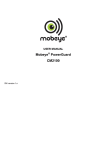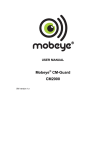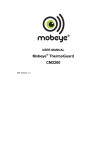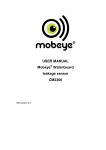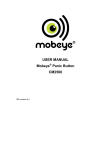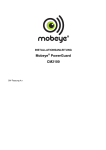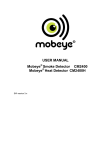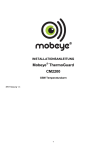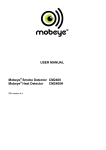Download Mobeye CM-Guard CM2000
Transcript
USER MANUAL Mobeye® CM-Guard CM2000 SW version 5.n CONTENT 1. General description 2. Getting started 2.1 2.2 2.3 2.4 2.5 2.6 2.7 4 5 Insert a SIM card Connect a sensor to the input Insert the batteries Enter the program mode Program at least one telephone number Switching on/off Confirmation of the alarm message 3. Use of external power supply 4. Configuration 4.1 4.2 4.3 4.4 9 10 Program mode The (security) code Programming the settings by SMS List of SMS commands for configuration 5. Possible settings 5.1 5.2 5.3 5.4 5.5 5.6 5.7 5.8 5.9 5.10 5.11 5.12 5.13 5.14 5.15 5.16 5.17 5 6 6 6 7 8 8 10 11 11 12 14 Phone numbers Identification text Alarm texts SMS on/off Call on/off Input type Exit delay time Alarm delay time Inactive time Alarm repeat time Power failure delay time Power failure message Automatic arming / disarming Buttonlock Low power mode Test message System reset 14 14 15 15 15 16 16 16 17 17 17 18 18 19 20 20 20 6. Request list of the status, settings and signal strength 7. Mobeye Internet Portal 8. Technical messages and status feedback 2 21 22 23 Attention! Very important This user manual contains important guidelines for the installation and usage of the Mobeye® device as described in this manual. Please read these thoroughly before you start using the Mobeye® device. In case of damage caused by disregarding the guidelines, the warranty becomes void. The user must regularly check the proper functioning of the device. The manufacturer cannot be held liable for any damage or loss caused by any incorrect use or incorrect functioning of the Mobeye® device. Safety guidelines • The permitted ambient temperature during operation may not be exceeded (not lower than -10°C and not higher than 50°C). • The device is intended for use in dry and clean places. • Protect the device from moisture, heat and water splashing. Not intended for external use. • The guidelines for the battery usage must be regarded. • Do not expose the device to strong vibrations. • Do not let it fall from height. • Do not use in an environment where any inflammable gases, vapors or dust are present or could be present. • Repair of the device may only be carried out by people, trained for Mobeye® repair. • If the device must be repaired, only original replacement components may be used. The use of different parts may lead to damage of the Mobeye ® device. Use in accordance with the regulations The purpose of this device in accordance with the regulations is sending SMS text messages and making telephone calls after an alarm situation. Other uses are not permitted and may invalidate the warranty. Battery recycling CR123 batteries, as used in the Mobeye CM-Guard, are classified as non-hazardous waste and can be recycled. Please take empty batteries to a nearest collection point. 3 1. GENERAL DESCRIPTION The Mobeye CM-Guard is a battery operated GSM module used to send an alarm notification after a triggered input or - if an external power supply is used- after a power failure. The factory settings of the Mobeye CM-Guard cause following reactions: - When one of the inputs is activated by a sensor, the Mobeye CM-Guard sends an alarm SMS text message and calls the phone numbers programmed in by the user. - When one of the inputs remain in the alarm status, the Mobeye CM-Guard repeats sending the SMS alarm message every four hours. - When the batteries need to be replaced, the Mobeye CM-Guard sends a ‘low battery’ SMS text message to the first telephone number (administrator). - When an external power supply is used and a power failure occurs, the Mobeye CMGuard sends a ‘power failure’ SMS text message to the first telephone number. When the power is restored, the Mobeye CM-Guard sends a ‘power restored’ SMS text message. The Mobeye CM-Guard has many options to influence the behaviour, which are described in chapter 4. For additional alarm and monitoring functions the Mobeye CMGuard can be connected to the Mobeye Internet Portal, which is explained in chapter 7. 4 2. GETTING STARTED To get started with the Mobeye CM-Guard, at least the following steps need to be taken in the following order: 1. 2. 3. 4. 5. 6. Insert a SIM card Connect a sensor to the input Insert the batteries Enter the program mode Program at least one telephone number Arming/disarming the system These steps are further explained in this chapter. After these steps the module will be operational. 2.1 INSERT A SIM CARD Open the enclosure by removing the 4 screws and insert a SIM card into the module. Push the black cover slightly outward to open the holder. Before installing the SIM card should have PIN code "0000", or PIN code removed. (A PIN code can be changed or removed by putting the SIM card in to any mobile phone and entering the 'security' menu.) NB: Make sure the SIM card is inserted before the batteries are inserted. If you replace a SIM card, first remove the batteries (and remove any other external power supply). The settings are stored in the device memory. The SIM card shall have the “normal” size and be suitable for 2G. It is advised to use an M2M SIM card. 5 2.2 CONNECT A SENSOR TO THE INPUT Two external sensors can be connected to the inputs. As a standard reaction after a triggered input, the Mobeye CM-Guard sends an SMS text message to the preset numbers and calls these numbers. Insert the 2 wires of an external sensor through the hole in the enclosure and insert them in the two connectors of input 1 (press on the green pins for connecting the wires). It does not matter which wire is connected to which connector. A second sensor can be connected to input 2. As default the inputs are programmed as Normally Open (NO) contacts. This means the inputs are triggered if the input is closed for at least 1 second. In case the contact is Normally Closed (NC), please refer to paragraph 5.4. If you require the sensor to be activated for a shorter or longer period before triggering an alarm, please refer to 5.7. 2.3 INSERT THE BATTERIES Insert the two batteries (CR123) in the module. Use the +/- indication for the correct placement. 2.4 ENTER THE PROGRAM MODE Directly after inserting the batteries, the Mobeye CM-Guard switches to the program mode. First the GSM module establishes network connection. During this time the LED flashes green and red. Within 10-30 seconds the connection is established and the status LED starts flashing 1 sec. on/1 sec. off (or stays on continuously in case the first telephone number has been configured). 6 The Mobeye CM-Guard returns to the program mode by pressing the on/off button for 5 seconds, until the LED starts flashing red/green. Once it has GSM connection it will be flashing again (or stays on continuously). As long as the unit is in program mode, the status green LED is on (or flashing 1 sec. on/1 sec. off if the module has no configuration). During the first 3 minutes, the GSM module remains active, ready to receive SMS commands. After 3 minutes a time-out occurs and the GSM module switches off in order to save the batteries. The unit returns to the low power operational mode. 2.5 PROGRAM AT LEAST ONE TELEPHONE NUMBER The Mobeye CM-Guard is able to send messages up to 5 telephone numbers. The first telephone number (TEL1) belongs to the administrator. Technical messages (such as battery low) are sent to the administrator only. Without the administrators’ phone number, the Mobeye CM-Guard cannot function. When the CM-Guard is in initial (factory) status and the batteries are inserted (so the LED is flashing), the administrators’ number is programmed by calling the telephone number of the Mobeye CM-Guard using the administrators’ phone. The unit will recognize this number and store it as administrator (TEL1). The administrator will receive a confirmation SMS text message including the security code. This code is needed to program the other settings in the unit. NB: For this way of programming the number recognition in the administrator’s phone must be ‘on’. To program or change the administrators’ number by SMS command, please refer to 4.2. 7 2.6 SWITCHING ON/OFF After the previous steps, the Mobeye CM-Guard is ready for use. It is armed (switched on) automatically. In order to switch off (disarm) the Mobeye CM-Guard: - Press the on/ off button at the upper side for 1 second. The green LED switches off to indicate the disarmed status. In the disarmed status the Mobeye CM-Guard will not send alarm notifications. The functions automatic arming and sending a ‘low battery’ message, are still active. In order to switch on (arm) the Mobeye CM-Guard: - Press the on/ off button at the upper side for 1 second. The green LED blinks once every 3 seconds (battery-powered) or stays ‘on’ continuously (in case of an external power supply). If powered externally (GSM is open), switching can be done via SMS commands: SMS command to switch on: SMS command to switch off: example: CODE ARM CODE DISARM 1111 ARM The status can be requested via SMS command CODE STATUS? (see chapter 6). 2.7 CONFIRMATION OF THE ALARM MESSAGE When the system is triggered it will send alarm notifications. First an SMS text message is sent to all programmed alarm numbers, followed by a phone call. When you pick up the phone, you will hear beeps. It is possible to confirm the phone call by answering the phone and pressing any key. The other alarm numbers will not be called afterwards. By switching off the ‘SMS’ function, the system will only call. This prevents the other numbers being notified by SMS. 8 3. USE OF EXTERNAL POWER SUPPLY Although the Mobeye CM-Guard is designed to run on batteries, it is possible to use an external power supply. In this mode the module is always connected with the GSM network and therefore always in program mode. When the power fails, the batteries take over and a power failure alarm message is sent. The module continues operating albeit in the low power mode. This means the GSM module switches off and only establishes network connection when it needs to send an alarm notification, test message or low battery alert. Connect the external power adapter (or any other regulated 12VDC power supply) to the power input of the connector (press on the green pins to connect the wires): - V+ (black lead with white stripe) to “+” - Ground (black lead) to “-“ 9 4. CONFIGURATION To program the Mobeye CM-Guard, the GSM module must have network connection. In case only batteries are used, first switch the unit to the program mode. Next send SMS commands for the configuration. All settings are stored and will be kept in the unit, even in case the power supplies are removed. 4.1 PROGRAM MODE If the unit is connected to an external power supply, the CM-Guard has continuous network connection and the unit is permanently in program mode. If the unit is battery-powered the program mode can be achieved by pressing the on/off button for 5 seconds, until the LED starts flashing red and green. Alternatively, the program mode can be accessed by (re) inserting the batteries. First the GSM module establishes network connection. During this time the LED flashes green/red. Normally this takes 10-30 seconds. Once the connection is established the status LED starts flashing 1 sec. on/1 sec. off (or stays on continuously in case the first telephone number has been configured). In program mode, the device is ready to receive SMS commands. If no correct command is received for 3 minutes, the GSM module switches off in order to save the batteries. The unit returns to the low power operational mode. The program mode is interrupted by pressing the on/off button for one second until the LED switches off. The unit is switched off completely (disarmed). 10 4.2 THE (SECURITY) CODE For configuration activities the (security) code of the Mobeye CM-Guard must be used. The initial (security) code is ‘1111’. You can change the (security) code to your own code. See section 4.4. 4.3 PROGRAMMING THE SETTINGS BY SMS To program the settings by SMS text message: 1. Make sure the CM-Guard is in program mode (please refer to 4.1). 2. Send an SMS text message with the (security) code and the command. 3. The green LED blinks 3 times to indicate the successful configuration. In case of an incorrect command, the red LED flashes 5 times. SMS messages have the following content: CODE COMMAND:OPTION - Do not forget the space character between (security) code and command. The commands are case insensitive. Several commands may be combined in one SMS message (with a maximum of 160 characters) by placing a # between the commands. CODE COMMAND:OPTION#COMMAND:OPTION#COMMAND:OPTION See section 4.4 for a full list of SMS commands. 11 4.4 LIST OF SMS COMMANDS FOR CONFIGURATION The setting options for the CM-Guard. The commands are case insensitive. Setting SMS Command Change security code INSTCODE: Set telephone number for TEL1: ... alarm messages TEL5: Delete telephone number DEL1 Options 0000···9999 Default value 1111 Empty 20 characters ON, OFF ON, OFF NO, NC NO, NC 0···999 (sec) 0···999 (sec) 0···999 (sec) 0···60 (min) 0···60 (min) 0···24 (hrs) 20 characters 20 characters 0···999 (min) Mobeye ... Identification text Call on/off SMS on/off Input type input 1 Input type input 2 Exit delay Delay on input 1 Delay on input 2 Inactive time input 1 Inactive time input 2 Alarm repeat time Alarm text input 1 Alarm text input 2 Power failure delay time Power message Actual time Actual date Arming time Disarming time 2nd arming time 2nd disarming time Assigning times 1 DEL5 NAME: CALL: SMS: TYPEIN1: TYPEIN2: DELAYEXIT: DELAY1: DELAY2: INACTIVEIN1: INACTIVEIN2: REPEAT: TEXT1: TEXT2: DELAYPOW: ON ON NO NO 0 1 1 0 0 4 Alarm 1 Alarm 2 0 POWERMESSAGE: OFF,ALERT,ALARM ALERT TIME: hhmm Empty DATE: yyyymmdd Empty TIMEARM1: hhmm Empty TIMEDISARM1: hhmm Empty TIMEARM2: hhmm Empty TIMEDISARM2: hhmm Empty DAYS1: 1234567 Empty 12 Setting Assigning times 2 Use of on/off button SMS Command DAYS2: BUTTONLOCK: Low power status Interval ‘test SMS’ Time test message LOWPOWER: TEST: TESTTIME: Options 1234567 ON (button locked) OFF (unlocked) ON, OFF 0···30 (days) hhmm Examples: Set phone number 1: 1111 TEL1:0712345678 Delete phone number 1: 1111 del1 Be aware of the space between “1111” and the command. 13 Default value Empty OFF OFF 0 5. POSSIBLE SETTINGS 5.1 PHONE NUMBERS The Mobeye CM-Guard is able to send alarm messages to up to 5 phone numbers. The first telephone number (TEL1) belongs to the administrator. Only this number receives all system messages. The other phone numbers (including the administrator) only get the alarm messages. To set or change telephone numbers: SMS command 1st telephone number: example: TEL1: 1111 TEL1:07123456789 ... similar for TEL2:, TEL3:,TEL4: and TEL5: For foreign numbers, start with + followed by the country code (depending on the country leave out the zero for the local area code). example: 1111 TEL1:+447123456789 To delete telephone numbers: SMS command delete 1st telephone number: DEL1 example: 1111 DEL1 ... similar for DEL2, DEL3, DEL4 and DEL5 5.2 IDENTIFICATION TEXT It is possible to add a standard identification text (NAME) to all messages sent out by the Mobeye CM-Guard. The alarm messages are a combination of the name and the alarm text. A user defined identification has a length of maximum 20 characters. The default identification text is ‘Mobeye’. SMS command identification text: example: NAME: 1111 NAME:my Mobeye device 14 5.3 ALARM TEXTS Unique alarm texts can be programmed into the Mobeye CM-Guard. User defined texts have a maximum length of 20 characters. Following default texts are programmed: Text 1 (input 1): Alarm 1 Text 2 (input 2): Alarm 2 Text 3: Power failure Text 4: Power restored NB: text 3 and 4 are only valid at POWERMESSAGE set to ‘ALARM’. SMS command text input 1 SMS command text input 2: SMS command text Power failure: SMS command text Power restored: example: TEXT1: TEXT2: TEXT3: TEXT4: 1111 TEXT2:garage door open 5.4 SMS ON/OFF By default, the Mobeye CM-Guard sends alarm notifications via text message and calls (you will hear a beep signal) to the preset contact persons. By turning off the SMS, the unit will only call after a triggered input. SMS command enable / disable SMS: SMS:ON or SMS:OFF example: 1111 SMS:OFF 5.5 CALL ON/OFF By default, the Mobeye CM-Guard sends alarm notifications via text message and calls the preset contact persons. By turning off the CALL, the unit will only send an SMS text message as alarm notification. It is not possible to switch off both the SMS and the call. SMS command enable / disable call: example: CALL:ON or CALL:OFF 1111 CALL:ON 15 5.6 INPUT TYPE The input type defines the character of the inputs IN1 and IN2. This can be Normally Open (NO) or Normally Closed (NC). If an input is set to NO, the alarm will be triggered as soon as the terminals of the input are closed. If the input is set to NC, the alarm is triggered when the connection between the input terminals is broken. The default input type is set to NO. SMS command input type input 1: SMS command input type input 2: example: TYPEIN1:NO or TYPEIN1:NC TYPEIN2:NO or TYPEIN2:NC 1111 TYPEIN1:NC 5.7 EXIT DELAY TIME The exit delay time defines the time between the moment of switching on the module – while the input is active – and the moment the module starts sending the first alarm message. Example: the module has been installed in a cabinet where a door magnet contact is connected to the input. The exit delay time is the time between switching on the module and closing the cabinet’s door. Only after this time has exceeded, alarm messages will be sent. The time can be set between 0 and 999 seconds. As default, the exit delay time is set to 0 second. SMS command exit delay: example: DELAYEXIT: 1111 DELAYEXIT:806 5.8 ALARM DELAY TIME The input delay time defines the time that the input is triggered before an alarm is initiated. If the input returns to the non-alarm status within the delay time, no alarm is sent. The time can be set between 0 and 999 seconds. As default, the input delay time is set to 1 second. SMS command alarm delay input 1: SMS command alarm delay input 2: example: DELAY1: DELAY2: 1111 DELAY1:999 16 5.9 INACTIVE TIME The “inactive time” defines the time an input is not active after an activation. During the inactive time, no new alarm message will be sent. Only when the input returned to the non-alarm status, gets activated again and remains active, an alarm will be sent yet after the inactive time. If the time is set to “0” (minutes), the input will be active again immediately after returning to the non-alarm status. The time can be set between 0 and 60 minutes. As default, the inactive time is set to “0”. SMS command inactive time input 1: SMS command inactive time input 2: example: INACTIVEIN1: INACTIVEIN2: 1111 INACTIVEIN2:45 5.10 ALARM REPEAT TIME In order to emphasize the urgency of the alarm messages, all alarms can be repeated. As long as the input has not returned to the inactive status, the SMS alarm will be repeated after the ‘alarm repeat time’. The time can be set between 0 and 24 hours. As default the alarm repeat time is set to 4 hours. SMS command alarm repeat time: example: REPEAT: 1111 REPEAT:20 5.11 POWER FAILURE DELAY TIME If the Mobeye CM-Guard is powered externally and the power fails it can notify the contact person(s). The power failure delay time defines the time between the initial power failure and the alarm notification. If the power is restored within the delay time, no alarm is sent. The time can be set between 0 and 999 minutes. As default, the delay time is set to 0. SMS command power failure delay time: example: DELAYPOW: 1111 DELAYPOW:15 17 5.12 POWER FAILURE MESSAGE If the Mobeye CM-Guard is powered externally and the power fails it sends an SMS text message to the administrator (setting: ‘ALERT’). The message is only sent in case the unit is armed. This message can be set to ‘ALARM’ or ‘OFF’. If the setting is ‘ALARM’ the power failure message will be sent to all contact persons (SMS and or CALL, following the SMS on/off and CALL on/off settings). The setting ‘OFF’ means that no power failure message is sent. The default setting for the ‘power failure message’ is set to “ALERT”. SMS command power failure message: example: POWERMESSAGE:ALARM (or ALERT or OFF) 1111 POWERMESSAGE:ALARM 5.13 AUTOMATIC ARMING / DISARMING The Mobeye CM-Guard only works if the unit is armed, which is done via the on/off button. It is possible to automatically arm and disarm the unit, based on an arming and/or disarming time scheme. Two schemes can be entered, which can be assigned to the days in the week (e.g. to have a different weekend scheme). For arming/disarming automatically, the internal clock time needs to be correct. Some telecom providers offer this in the network, which the Mobeye CM-Guard synchronizes during start-up and after sending test messages. It is possible to set the time manually. To view the clock time, request a list of the settings by sending the command 1111 SET?. To set the actual date: SMS command actual date: DATE: To set the actual time: SMS command actual time: TIME: To set a daily arming scheme: SMS command arming scheme 1: TIMEARM1: 18 To set a daily disarming scheme: SMS command disarming scheme 1: TIMEDISARM1: To set a second daily arming scheme: SMS command arming scheme 2: TIMEARM2: To set a second daily disarming scheme: SMS command disarming scheme 2: TIMEDISARM2: example: 1111 TIMEDISARM2:1455 As default the automatic (dis) arming times are valid for all days. It is possible to assign them to a few days in the week. In this way it is possible to have two different schemes, which are valid on different days. To assign TIMEARM and/or TIMEDISARM to weekdays: SMS command to assign ‘scheme 1’: DAYS1: SMS command to assign ‘scheme 2’: DAYS2: As value the weekdays can be entered. Monday is 1, Tuesday is 2, etc. If the scheme is valid for several days, the days can be entered in one command (e.g. 12345 means Monday till Friday). examples: 1111 DAYS1:12345 1111 DAYS2:67 5.14 BUTTONLOCK It can be useful to lock the on/off button to prevent the unit from being switched off unintentionally. As default the buttonlock is unlocked (so, the button is enabled). To disable the button, the buttonlock needs to be switched to on. SMS command buttonlock: example: BUTTTONLOCK: 1111 BUTTONLOCK:ON 19 5.15 LOW POWER MODE A battery-powered Mobeye CM-Guard has the GSM module switched off in stand-by mode. It only switches on if it has to send a message. An externally powered unit always keeps the GSM module open (as factory default). When using the “low power mode” an externally powered unit will also keep the GSM module closed as much as possible, to minimize the power consumption. To achieve this, the LOWPOWER shall be set to ON. In the low power mode, the presence of the external power source will still be monitored. SMS command low power mode: example: LOWPOWER: 1111 LOWPOWER:ON 5.16 TEST MESSAGE The Mobeye CM-Guard can send regular test SMS messages (keep alive) to the administrator (first phone number), to ensure the proper functioning of the unit. The test message function is only active if the unit is armed. The timing of the test message is determined by the time of programming. The test time can also be programmed. The interval between the test messages can be set between 0 days (no test message) and 30 days. The default test interval is set to 0 (no test message). SMS command interval test message: TEST: example: 1111 TEST:21 5.17 SYSTEM RESET To reset the Mobeye CM-Guard to its factory settings: 1. Remove the batteries (and external power supply). 2. Press the outside button while reinserting the batteries. Keep it pressed for (about) another 5 seconds. 3. Release the button immediately after the LED starts to flash. 4. If relevant, connect the external power supply. After a successful reset, the status LED on the keypad will blink green to indicate that the module is not configured. The security code is back to factory settings as well. 20 6. REQUEST LIST OF THE STATUS, SETTINGS AND SIGNAL STRENGTH Several lists and status reports can be retrieved by sending an SMS text message to the Mobeye CM-Guard, from any telephone. Before sending the request, make sure the unit is in the program mode (please refer to 4.1). Upon sending the command, the Mobeye CM-Guard returns an SMS text message to the originator of the request. The commands are case insensitive. STATUS REQUEST The status can be requested by sending following SMS text message. The status includes the armed/disarmed status, status of the inputs, power and batteries. SMS command status request: example: STATUS? 1111 STATUS? LIST OF SETTINGS The settings can be requested by sending following SMS text message: SMS command list basic settings: SMS command list advanced settings: SMS command list of texts: example: SET? SETA? TEXT? 1111 SET? LIST OF PHONE NUMBERS The list of telephone numbers can be requested by sending following SMS text message: SMS command list of phone numbers: example: CALL? 1111 CALL? GSM SIGNAL STRENGTH The signal strength of the used mobile network can be requested. If the network is weak, it is advised to use a SIM card of another network provider or an external GSM antenna (a Mobeye accessory). The GSM signal strength can be requested by sending following SMS text message: SMS command request GSM signal: example: NETWORK? 1111 NETWORK? 21 7. MOBEYE INTERNET PORTAL The Mobeye CM-Guard sends GSM messages to the preset contact persons. It is also possible to connect the system to the Mobeye Internet Portal. In this secured internet environment the Mobeye CM-Guard system(s) can be administered. The portal offers various functions: 1) the portal forwards alarm messages to contact persons (SMS and/or mail), which are set in the portal. The receivers of alarm messages may be different from the receivers of technical messages. Alarm phone calls will still be done directly from the Mobeye CM-Guard. 2) the name and location can be set in the portal. This name is used in SMS and mail messages. 3) the device settings can be programmed through the internet portal or via SMS command. 4) once connected to the internet portal, test messages (‘keep alive’) will be sent regardless the armed or disarmed state. The portal will check the receipt of test messages (‘keep alive’); when the message was not received on time, it sends an exception message. Look at www.mobeye.eu/portal for more information. 22 8. TECHNICAL MESSAGES AND STATUS FEEDBACK Technical messages In the event of technical issues the administrator receives an SMS message. Possible technical messages are: Message Low batteries, external power supply OK No external power supply, batteries OK Low batteries, no external power supply External power supply OK, batteries OK (delayed message) Reason Power is available, batteries need to be replaced. No external power supply, batteries are able to take over operation in low power mode. No external power supply, batteries need to be replaced. The external power is restored (or the adapter is plugged in a socket), batteries do not need to be replaced. If (delayed message) is added to the SMS text messages, the message couldn’t be sent earlier, due to a SIM card failure or GSM network failure. When receiving one of the above mentioned technical messages, please take appropriate action as soon as possible. During the battery replacement, the SIM card does not have to be removed. 23 Status feedback LED pattern Blinking green, 1 second on / 1 second off 1 green flash every 3 seconds Green LED stays on continuously Flashing red/ green every second 2 flashes red, every 3 seconds Status Module not configured Module is switched on, powered by batteries Module is switched on, powered by an external source Module establishes network connection No GSM connection 3 flashes red, every 3 seconds No valid SIM card or wrong PIN Blinking 3 times green Successful programming action Faulty programming action Low batteries Blinking 5 times red 4 red flashes every 3 seconds 24 Required action Configure at least one telephone number. No action required. No action required. Wait until the network connection is established. Try the SIM card in any mobile telephone; replace SIM card using other telecom provider; try the module at another location. Try the SIM card in any mobile telephone; remove PIN code; check credit; replace SIM card. No action required. Check SMS command. Replace both batteries. Technical specifications GSM : Quad band EGSM, 850/900/1800/1900 MHz Batteries : 2* CR123 (lithium) Battery life in normal mode : >1 year (battery operated) : >2 years (external power supply) Ext. power connection : 12 VDC (+/- 2 VDC) / min. 500 mA (optional) Power consumption low power : ca. 50 μA stand-by / max. ca. 500 mA Power consumption 12V : ca. 50 mA stand-by / max. ca. 500 mA Dimensions : 80 x 60 x 30 mm Ambient temperature : -10 °C until +50 °C This manual is published by Mobeye®. All rights, the translation included are reserved. Any reproduction, either photocopy, microfilm or saved in an automated data dictionary, only after written approval of the Publisher. Reprinting, even in summary, is prohibited. This user manual meets the technical requirements at the moment of printing. Changes in technology and equipment are reserved. © Copyright 2018 by Mobeye, version CM2000EN180201 25 26


















